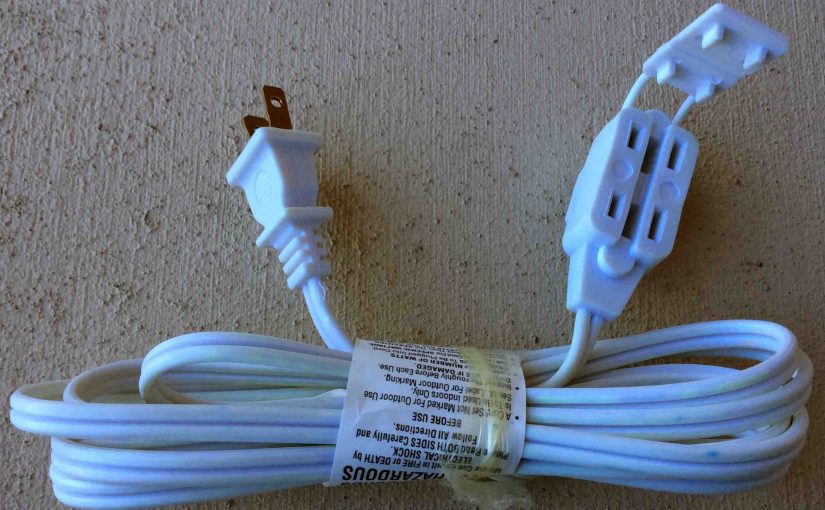Today’s electric extension cords give fast and easy ways of getting power around the home, garage, basement, and outdoors. They allow you to run leaf blowers, weed whackers, and lawn mowers outdoors. Plus, they connect lamps, radios, and televisions inside. But while these cords give instant power anywhere needed, extension cord safety should never be taken for granted. Think about how to place the cords based on the area. Also think what you’ll fit to them, for the most safety. We offer these tips to help you buy and use these devices safely.
Extension Cord Safety Intro
With today’s use of energy-thirsty devices, the supply of outlets in older homes and newer homes alike, often runs low. Given that, the multi-outlet extension can save the day. Why? Because using these ad hoc cords costs much less than hiring an electrician to install more outlets. These cords are faster to set up as well. And, they can reach places that permanent wiring does not.
But when used improperly, safety suffers. Overloading or using the cords in hazardous places, can make them unsafe. People often trip over poorly placed cables, severely hurting themselves.
Plus, you often break cords with foot traffic on them, or by rolling heavy vehicles over them. This abuse makes short circuits, and creates shock hazards. Cords can break down over time too, posing low but growing risks to health of those nearby. Further, the prongs on their plugs can tarnish. That dulling makes high resistance and a less sure fit. These faulty joints can make overheating and melting of plug and outlets. Furthermore, the insulation can dry out and peel off, leaving energized wires exposed.
But like with most tools, extension cord safety rises when you follow these tips for placement and use. Indeed, we’ve never seen any fires firsthand. We haven’t seen shocks, or falling due to tripping over these cables, though these do happen sadly. But our point is that these easy-to-follow guidelines can assure low-risk operation. So people should not fear these cables used in the right ways. They are safe when used correctly.
Extension Cord Safety Tips for Indoor Cords
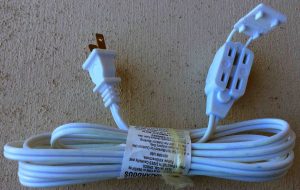
For Greater Extension Cord Safety, Buy Only UL, ETL, or CSA Approved Cords
This all but assures that the cord meets minimum safety codes. It’s true that the Underwriters Laboratories (UL) approved cords better withstand the rigors of home use. But that UL seal does not imply cord safety always. That seal just means that you’re starting with a decently safe cable. Then, if you follow its instructions, the cord will likely stay safe for years to come. One of the key safety tips, is to follow to the letter, any instructions that come with the extension cord.
Use Extension Cords for Short Lived Jobs Only
Holiday lighting, house cleaning, and yard work are good uses for extension cords. Having to lay out the cords for those Christmas decorations allows for easy searching each time you do it. So does dragging them to the yard for your bi-weekly weed whacking. Getting them out and putting them away after each job, lets you check out the cords before each use. Then, you can fix any faulty ones.
But, in permanent applications, the cord can become damaged, frayed, corroded, or burnt without the user knowing. Why? Because we typically do not check extension cords run behind couches, dressers, and love seats for faults that often. Frequent checking though, improves overall extension cord safety.
Do Not Over Load Extension Cords
Among the most important tips, this is one. Many smaller cords, can overheat and pose fire hazards when over taxed. These lighter duty cords are for radios, lamps clocks, and curling irons. So don’t use them on heavy duty devices like tools, hair dryers, heaters, and so on. Always check that you’re not exceeding the cord’s total power handling specs. The sum of all the device powers you’re attaching to it, should not exceed its rated power. If it does, the cord may get too hot. This could cause burns or start fires.
Plus, this situation will not trip the house circuit breaker if the cord’s rating is lower than the breaker rating. This often occurs with thinner cords. These have max current ratings of 8, 10, or 12 amps. Yet the branch circuits these cords plug into, are 15 or 20 amps. So, the main breaker will not cut out if the current in the cord is less than the breaker rating. Thus, if you must use extension cords, buy a heavy one. It should handle at least the same current as the household branch circuit. Over rate the cord therefore. That is, buy a bigger cord than you need. Why? Because over fudging lowers overheating chances. Plus, it enhances extension cord safety. Under loading the cords is one sure-fire way, so to speak, to boost extension cord safety.
Three Extension Cord Outlets Does Not Mean you can Safely Operate Three Devices
Many multi plug cables have three outlets. So, these convert one input outlet (the wall socket) into three outlets at the other end.
Yet extension cord safety can suffer if you carelessly fill all three outlets. Device groups that exceed the cords current rating can warm the cord too much. Doing this could exceed the max current rating of the cord. But using all three cord outlets is indeed safe, if the total current stays less than the max cord rating.
For example, the devices you plug in draw 18 amps. Yet your cord rates at just 12 amps. This means big trouble. You have major problems because you are overloading the cord, and could create a fire risk.
On the other hand, you can utilize all three outlets, for lower current devices. Three radios or bedroom lamps for example, will not heat the cord much at all. Therefore, plug only one high current device into any extension cord, even if that lead has three sockets. Knowing how much current each device draws, supports informed decisions about how many devices and tools can operate from the same cord. Heading off overloads goes far to yield the best extension cord safety possible.
Avoid Repeated Bending
Bending or flexing the extension cord can break the wire strands inside. This lowers the cord’s safe current handling amount and can create overheating hazards. These could trigger fires and other safety threats. Thus, keep the cord away from doorways. Avoid slamming the cord in the doors or stepping on it. Finally, do not lay them on vibrating surfaces.
Do Not Route Extension Cords Around Sharp Corners
If the corner is really sharp, such as around some table legs, pulling the cord can nick or cut it. This can make short circuits and shock hazards. Straight cord runs are safest therefore, although if you must bend the cord, do so gradually. Just as a kinked garden hose causes water flow problems, so too, a kinked cord can reduce extension cord safety.
Avoid Using Extension Cords in Very Hot or Cold Places
When you run an extension cord in very cold weather, it may get brittle. Its insulation can become so stiff that it cracks if you bend it. Or, the insulation may bet too soft if used in very hot places. These include attics during sunny summer days. The cord jacket can grow so soft that it might separate from the conductor wires. In either case, short circuits or electrical shocks can result. So, to keep your extension cords safe, avoid using them in temperature extremes.
Avoid Laying Extension Cords in High Traffic Places
If you must use an extension cord, route it well away from walked on areas. Avoid doorways, underneath carpets. Further, do not route the cord across the center, open part of a room. Only run the cord along walls.
Avoid high foot traffic areas, because people stepping on the cord causes excessive flexing. As discussed above, flexing lowers cable safety. How so? Well, it raises the odds that the cord will short out or shock someone.
Extension Cords Should Not Substitute for Permanent Wiring
Never route cords inside or through walls and ceilings. Do not lay them under floors, or places that make regular cord checkout impossible.
Also, the temperature ratings of extension cords are far below those of permanent wiring. This means that in-wall cable runs can pose much danger. So, do not do it. Your safety depends on checking the cords regularly. Therefore, put them only where you can easily check them often.
Wet Places can Reduce Extension Cord Safety
The insulation on most cords resists water when new. But don’t count on that to stay true, unless they built your cord for wet places. Cords named safe for wet places on the label, often have a GFIC breaker on the plug end. The GFIC lowers the effects of electric shocks that could occur in wet places. They also have rubber boots around their sockets and plugs, to keep the water out.
Most run-of-the-mill cables though, do not have these safety features. So unless your extension lead does, do not lay it in or near water. Further, avoid routing even the safest rated cords through standing or flowing water.
No Stapling of Extension Cords
Another of the extension cord safety tips you should pay real attention to, is to not staple or nail them. Careless stapling can puncture cable insulation, making short circuits and shock hazards. Further, over time, the cable can expand, contract, or shift position. When stapled, such shifts can erode the insulation, especially when you tightly clamp the cable when installing it. Tight stapling could make electrical shorts and hazards, years after installation. So, to maintain safety, do not permanently fasten them anywhere.
Scan Cord Parts Often to Maintain Extension Cord Safety
Every time you use an extension cord, look over the cable, checking for tears, nicks, cuts, and frays. Replace any cords showing these symptoms. Or at least, repair any bare wires with high-grade electrical tape.
Also, examine all prongs and socket contacts. For safest current handling, all prongs and contacts should gleam brightly. Extension cord safety tips like this one are key to cutting the risk of overheated and melted cord plugs and sockets.
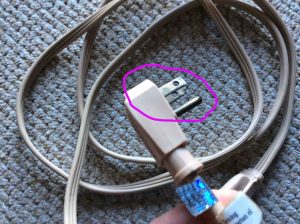
Dull or corroded prongs can cause hot joints due to the added resistance that corroded or dirty contacts makes. Clean or replace any corroded plugs and sockets to preserve extension cord safety.
Fully Push In All Plugs
You don’t get the rated safe current handling, unless you fully insert its plug into the wall outlet. Also, the tool plug should fully plug into the extension cord’s socket at the other end. You should not see prongs or contacts at either end
Partially plugged in plugs are bad for at least two reasons. First, they’re easier to touch, making a shock hazard. Second, with exposed prongs, the joint can grow hot. That heat might melt surrounding insulation on the cord. Poor contact can also overheat the wall outlet too. So, keep plugs fully plugged in for the most extension cord safety.
Further Extension Cord Safety Tips: Check for Low Heating
Any time you change the devices the cord powers, check it out. At least once per month, look over the cord at both ends. Feel for excess warmth if used often. Symptoms of over-current heating include softening of the plastic or rubber around plugs and sockets. You may also see color change on any part of the cord. Fading colors could mean over-heating has happened. Or you might notice a “hot” rubbery smell when using the cord.
Such heating occurs more at each end of the extension cord. But hot spots can happen anywhere along the cable too. So run your fingers along the entire cord while using it. Look for these hot spots and replace the cord if you find any. Furthermore, if the whole cord is too warm to touch, replace it. Buy a higher current one for improved extension cord safety.
Extension Cord Safety Tips for Outdoors
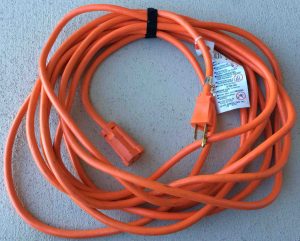
For Outdoor Use, Plug into Only GFCI Outlet
For all outdoor applications, plug all extension cords into GFCI protected outlets only. Better yet, use only exterior extension cords that feature built-in GFCI breakers. Or, if you can’t afford GFIC extension cords, just buy a GFCI box. Then, you plug your cord into this box. Next, plug this GFCI box into a wall outlet. The box adds GFCI safety to any cord plugged into it, but at a cheaper cost.
Keep All Electrical Connections Dry
Do not expose them to water or other chemicals, unless for the express purpose of cleaning and de-corroding them. Repeated exposure to dampness and wetness can corrode the prongs. This is especially so on brass plugs and sockets. Prong corrosion degrades how well the extension cord works as well as overall extension cord safety.
Run the Least Length Needed
Keep the extension cord short! The longer the cord the higher its resistance, and the less power it will deliver. This can reduce device function, and make low-voltage situations that can hurt tools and other devices. So, besides using the thickest practical cord, use a short one too. Both rules help raise extension cord safety higher.
Short cords not only maximize high current device working well (such as hair dryers). But less cable means less trip hazard as well and more extension cord safety. Less cord also means less wasted power as well.
Finally, shorter cords cost less, and are less prone to breakage.
Use Extension Cords with Built In Circuit Breaker
To reduce the chances of overloading the extension cord, buy only models that feature a built-in circuit breakers. Often found in cords designed for outdoor use, cord-bound circuit breakers are part of the GFCI breaker switch. Not only does the GFIC breaker guard against ground faults. But it also trips out if you exceed the extension cord’s max current rating. Avoiding these overloads not only lengthens the extension cord’s useful life. But it improves extension cord safety during its life as well.
Avoid Coiling Long Extension Cords to Shorten Them
Keep them straightened out. The coiled wire itself can act as an inductor. This can cause lower voltage at the appliance. That lower voltage in turn, can trigger faulty operation of that appliance. Again, this may hurt the appliance as well. Further, the coiled cord itself can overheat, at the coiled part, causing insulation failure and fire. Again, use the shortest extension cord you can to preserve extension cord safety.
Avoid Daisy-Chaining Extension Cords
The more cords you plug end-to-end, even the heavy duty ones, the more failure points. Why? Because the more connections you have, the more there are to come undone due to yanks and pulls. Plus, each socket-to-plug fitting adds more total resistance to the link. This, as discussed above, can degrade performance of high-current devices. So, extension cord makers design them for one-at-a-time use. Do not hook them end to end (in series).
Block Off Any Unused Extension Cord Sockets
Single outlet covers cost little. Yet they prevent children from inserting things into socket holes and perhaps shocking themselves. For the outdoors, these covers stop much moisture from entering the cord socket and causing short and shock hazards. Therefore, we suggest stopping up all open outlets to further reduce shock hazards.
Do Not Use Indoor Extension Cords Outdoors
Indoor cords are easier to find and cost less. But they’re less water resistant, less sun resistant, less rugged, and lighter duty than the outdoor ones.
On the other hand, outdoor cords, though costing more, can take more twisting, crushing, and bending, without failing. They have UV shield jackets. So they do not grow as brittle baking in the sun as an indoor cord might. Finally, you find brighter colored cables outdoors (except for garden lighting ones). So they pose less of a tripping danger.
Extension Cord Safety Tips Wrap Up
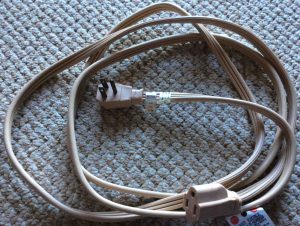
Society couldn’t get along without the millions of cords out there these days. People use them in bedrooms, living rooms, offices, and concert stages to get power where they need it. You can quickly set up and take down extension leads. Plus, they cost little. Thus, their good points far outweigh their risks.
But you get rid of almost all cord woes, by best using them. We hope the extension cord safety tips in this post tell you much about how to hook up these cables in the safest ways.
Related Posts to Extension Cord Safety
Other Posts About Cords and Cables
References for Extension Cord Safety
Revision History
-
- 2019-05-13: Added tags, tuned the targeting for ‘extension cord safety’, and removed the ad code scripts.
- 2018-03-24: Revised post title and content.
- 2017-01-28: Updated tags list. Changed post title to: Electric Extension Cord Safety Tips.
- 2015-10-17: Added appropriate tags.
- 2015-09-19: Added discussion about indoor Vs. outdoor extension cords.
- 2015-09-14: Originally published.
